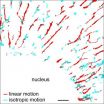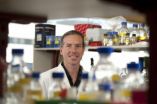(Press-News.org) WASHINGTON, D.C. (March 6, 2011) -- New findings from researchers at Harvard Medical School in Boston and the Hospital for Sick Children in Toronto may shed light on the mechanisms that regulate the organization of receptors on the cell surface, a critical aspect of cell signaling not well understood at this time.
The group reports on their use of the macrophage protein CD36, a clustering-responsive class B scavenger receptor, as a model for studying the processes governing receptor clustering and organization. The protein is involved in a number of cellular and physiological functions that range from lipid metabolism to immunity, but it is unknown how the CD36 protein is organized in the cell (as monomers or as oligomers) and how that organization leads to its biological functions.
The researchers employed a combination of powerful tools: quantitative live-cell single-molecule imaging and biochemical/pharmacological approaches to study the dynamics, oligomerization and signaling of CD36 in primary human macrophages.
The group reports that movement of CD36 in the macrophage plasma membrane is regulated by the sub-membranous actin meshwork and by microtubules, demonstrating that these cytoskeletal components might play a critical role in receptor function, in general.
In terms of the impact of this research, lead researcher Khuloud Jaqaman says: "In the long run, establishing the relationship between receptor organization and cell signaling might aid in the development of drugs since receptors on the cell surface are the most accessible to pharmacological manipulation."
INFORMATION:
The presentation, "CYTOSKELETAL CONTROL OF RECEPTOR DIFFUSION IN MEMBRANE PROMOTES CD36 FUNCTION AND SIGNALING" by Khuloud Jaqaman, Hirotaka Kuwata, Nicolas Touret, Richard Collins, William S. Trimble, Gaudenz Danuser, and Sergio Grinstein is at 11:30 a.m. on Sunday, March 6, 2011 in Room 307 of the Baltimore Convention Center. ABSTRACT: http://tinyurl.com/4omy687
NOTE TO EDITORS: An image is available to accompany this story. Visit URL
IMAGE CAPTION: CD36 trajectories in a primary human macrophage from a 10 Hz/10 s single-molecule movie. Scale bar, 2 µm. Red, linear trajectories; cyan, isotropic trajectories. The linear motion of receptors, which depends on the actin meshwork and on microtubules, enhances receptor clustering in the absence of ligand, priming the macrophages to respond when exposed to ligand.
IMAGE CREDIT: Reporters and editors may freely use this image so long as they credit: K. Jaqaman/Harvard Medical School.
This work was funded by the National Institutes of Health, the Center for Cell Decision Processes (NIH P50), the Heart and Stroke Foundation of Ontario, and the Canadian Institutes of Health.
MORE MEETING INFORMATION
Each year, the Biophysical Society Annual Meeting brings together more than 6,000 scientists and hosts more than 4,000 poster presentations, 200 exhibits, and more than 20 symposia. The largest meeting of its type in the world, the Biophysical Society Annual Meeting retains its small-meeting flavor through its subgroup meetings, platform sessions, social activities, and committee programs.
QUICK LINKS
Meeting Home Page:
http://www.biophysics.org/2011meeting
General Meeting Information:
http://www.biophysics.org/GeneralInfo/Overview/tabid/2062/Default.aspx
Search abstracts:
http://www.abstractsonline.com/plan/start.aspx?mkey={FEA830A5-24AD-47F3-8E61-FCA29F5FEF34}
PRESS REGISTRATION
The Biophysical Society invites credentialed journalists, freelance reporters working on assignment, and public information officers to attend its Annual Meeting for free. For more information on registering as a member of the press, please contact Ellen Weiss at eweiss@biophysics.org or 240-290-5606. Also see: http://www.biophysics.org/Registration/Press/tabid/2148/Default.aspx
ABOUT THE BIOPHYSICAL SOCIETY
The Biophysical Society, founded in 1956, is a professional, scientific society established to encourage development and dissemination of knowledge in biophysics. The society promotes growth in this expanding field through its annual meeting, monthly journal, and committee and outreach activities. Its over 9,000 members are located throughout the U.S. and the world, where they teach and conduct research in colleges, universities, laboratories, government agencies, and industry. For more information on the society or the 2011 Annual Meeting, visit www.biophysics.org
The connection between a cell's cytoskeleton and its surface receptors
Critical aspect of cell signaling described today at Biophysical Society Meeting in Baltimore
2011-03-07
ELSE PRESS RELEASES FROM THIS DATE:
Scientists probe the role of motor protein in hearing loss
2011-03-07
WASHINGTON, D.C. (March 6, 2011) -- From grinding heavy metal to soothing ocean waves, the sounds we hear are all perceptible thanks to the vibrations felt by tiny molecular motors in the hair cells of the inner ear. Researchers at the University of Pennsylvania School of Medicine have now identified the mechanism by which a single amino acid change can disrupt the normal functioning of one of the critical components of that physiology -- a molecular motor protein called myo1c, which resides in the cochlea of the inner ear.
The mutation (called R156W), was first identified ...
Avoid risking children's health during home energy retrofits, renovations, experts urge
2011-03-07
Home energy retrofits tackle climate change and when done right they should make homes healthier, while aiding families struggling with utility bills.
Without adequate training and precaution, however, renovators, energy retrofitters and do-it-yourselfers who disturb lead-based paint, asbestos insulation and other toxic materials in older buildings put the health of all -- especially children -- living there at risk of serious health impacts.
Lead exposure can potentially lead to lowered intelligence and worse; asbestos exposure can potentially lead to debilitating ...
New role for an old molecule: protecting the brain from epileptic seizures
2011-03-07
PROVIDENCE, R.I. [Brown University] — For years brain scientists have puzzled over the shadowy role played by the molecule putrescine, which always seems to be present in the brain following an epileptic seizure, but without a clear indication whether it was there to exacerbate brain damage that follows a seizure or protect the brain from it. A new Brown University study unmasks the molecule as squarely on the side of good: It seems to protect against seizures hours later.
Putrescine is one in a family of molecules called "polyamines" that are present throughout the body ...
Rehabilitation within a day of knee replacement pays off
2011-03-07
Starting rehabilitation sooner following knee arthroplasty surgery could pay dividends - for both patients and hospitals. Commencing physical therapy within 24 hours of surgery can improve pain, range of joint motion and muscle strength as well as cut hospital stays, according to new research in the journal Clinical Rehabilitation, published by SAGE.
Mindful of the trend towards discharging patients from hospital more rapidly after surgery in recent years, physical therapy and public health researchers from Almeria, Malaga and Granada in Spain set out to investigate whether ...
Leicester leads on heart attack genetic link discovery
2011-03-07
The largest-ever study of its type into coronary heart disease, involving scientists from the University of Leicester, has uncovered 13 new genes that increase risk of heart attacks.
Professor Nilesh Samani, British Heart Foundation Professor of Cardiology at the University of Leicester, based at Glenfield Hospital, who co-led the international research programme, called CARDIoGRAM, said most of genes identified were not previously known to be involved in the development of coronary heart disease, opening of the possibility of developing new treatments for this common ...
New gene regions identified that predispose people to heart attacks, Stanford scientists say
2011-03-07
STANFORD, Calif. — Thirteen new gene regions have been convincingly linked to coronary atherosclerosis in a massive, new, international genetics study involving investigators from the Stanford University School of Medicine.
The results of the study, to be published online March 6 in Nature Genetics, provide 13 vital new clues on the etiology of this disease, the most common cause of death worldwide. The study doubles the number of gene regions previously known to predispose people to this condition. Coronary atherosclerosis is the process by which plaque builds up in ...
Gene responsible for severe osteoporosis disorder discovered
2011-03-07
Scientists have identified a single mutated gene that causes Hajdu-Cheney syndrome, a disorder of the bones causing progressive bone loss and osteoporosis (fragile bones). The study, published in Nature Genetics today, gives vital insight into possible causes of osteoporosis and highlights the gene as a potential target for treating the condition.
There are only 50 reported cases of Hajdu-Cheney syndrome (HCS), of which severe osteoporosis is a main feature. Osteoporosis is a condition leading to reduction in bone strength and susceptibility to fractures. It is the most ...
New report helps inform decisions about how science should be funded
2011-03-07
Clinical research has greater societal impact over a 15-20 year timescale, while basic research has greater academic impact, according to a new study from RAND Europe and the Health Economics Research Group (HERG) at Brunel University.
Project Retrosight was a multinational, four-year study that investigated the translation of basic biomedical and clinical cardiovascular and stroke research, and its impact on future work, policy, products and healthcare. The study was based on a rich source of material taken from 29 carefully selected case studies of grants for research ...
Landmark study links 13 new genes to heart disease
2011-03-07
OTTAWA – March 6, 2011 – Insight into the complex biological mechanisms that cause heart disease has taken a major step forward with the discovery of 13 new genes that increase the risk of coronary artery disease (CAD). The influence of the majority of the new genes is independent of other established risk factors, suggesting new, unsuspected causes of CAD. The discovery more than doubles the number of genes known to affect the progression of heart disease.
The research also verified the association of 10 previously identified genes to the population at large, meaning ...
Newly identified cell population key to immune response
2011-03-07
Scientists from the Walter and Eliza Hall Institute have identified the key immune cell population responsible for regulating the body's immune response.
The finding could have wide-ranging repercussions for the treatment of autoimmune diseases, organ transplantation and cancer, and change how the efficacy of newly developed drugs is measured.
The discovery was made by Dr Erika Cretney, Dr Axel Kallies and Dr Stephen Nutt from the institute's Molecular Immunology division. It centred on a population of immune cells called regulatory T cells.
Regulatory T cells (T-regs) ...
LAST 30 PRESS RELEASES:
National poll: Less than half of parents say swearing is never OK for kids
Decades of suffering: Long-term mental health outcomes of Kurdish chemical gas attacks
Interactional dynamics of self-assessment and advice in peer reflection on microteaching
When aging affects the young: Revealing the weight of caregiving on teenagers
Can Canada’s health systems handle increased demand during FIFA World Cup?
Autistic and non-autistic faces may “speak a different language” when expressing emotion
No clear evidence that cannabis-based medicines relieve chronic nerve pain
Pioneering second-order nonlinear vibrational nanoscopy for interfacial molecular systems beyond the diffraction limit
Bottleneck in hydrogen distribution jeopardises billions in clean energy
Lung cancer death rates among women in Europe are finally levelling off
Scientists trace microplastics in fertilizer from fields to the beach
The Lancet Obstetrics, Gynecology, & Women’s Health: Taking paracetamol during pregnancy does not increase risk of autism, ADHD or intellectual disabilities, confirms new gold-standard evidence review
Taking paracetamol during pregnancy does not increase risk of autism, ADHD or intellectual disabilities
Harm reduction vending machines in New York State expand access to overdose treatment and drug test strips, UB studies confirm
University of Phoenix releases white paper on Credit for Prior Learning as a catalyst for internal mobility and retention
Canada losing track of salmon health as climate and industrial threats mount
Molecular sieve-confined Pt-FeOx catalysts achieve highly efficient reversible hydrogen cycle of methylcyclohexane-toluene
Investment in farm productivity tools key to reducing greenhouse gas
New review highlights electrochemical pathways to recover uranium from wastewater and seawater
Hidden pollutants in shale gas development raise environmental concerns, new review finds
Discarded cigarette butts transformed into high performance energy storage materials
Researchers highlight role of alternative RNA splicing in schizophrenia
NTU Singapore scientists find new way to disarm antibiotic-resistant bacteria and restore healing in chronic wounds
Research suggests nationwide racial bias in media reporting on gun violence
Revealing the cell’s nanocourier at work
Health impacts of nursing home staffing
Public views about opioid overdose and people with opioid use disorder
Age-related changes in sperm DNA may play a role in autism risk
Ambitious model fails to explain near-death experiences, experts say
Multifaceted effects of inward foreign direct investment on new venture creation
[Press-News.org] The connection between a cell's cytoskeleton and its surface receptorsCritical aspect of cell signaling described today at Biophysical Society Meeting in Baltimore


